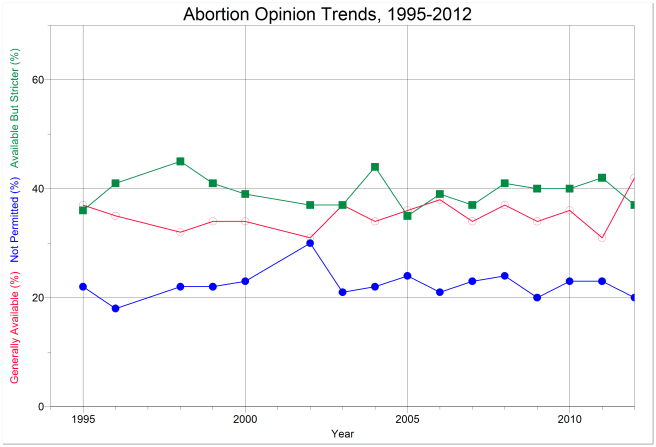
Abortion and reproductive rights have been on many people’s minds during this recent election season, especially in the aftermath of Representative Todd Akin’s now infamous remarks on “legitimate rape”. In the forty years since the Supreme Court ruled that women have a fundamental right to choose, the opposition to abortion has only gotten stronger. As I’ve touched on in previous posts, part of Mitt Romney’s platform included defunding Planned Parenthood, a move which was unsurprising in light of a much greater recent increase in anti-abortion legislation. While abortion rates are dropping for the first time in years, this decrease is being attributed to increases in contraceptive usage, not abortion restrictions.
A report from the Guttmacher Institute showed that in 2011 more than 1,100 reproductive health and rights-related provisions were introduced by legislators throughout the US, a sharp increase from 2010, which saw only 950. These pieces of abortion legislature took many forms, including bans, waiting periods, and ultrasound requirements, with the end result being that it is now harder in America for a woman to get an abortion than it has been in decades.
While you might assume that the sharp increase in anti-abortion legislature has been due to more women wanting abortions, the opposite is actually the case. A recent government study shows that during the recession and its aftermath, abortion rates have actually fallen by five percent, the largest decrease in a decade. Experts believe that this decrease is due to women fearing that they cannot afford to have children, and being more careful about contraception. Up to 60% of teenage girls are using the pill or the patch, which is a big increase from the 90’s when less than half of girls were using these highly effective contraceptives. IUD usage also increased, from 3% in 2002 to more than 8% in 2009. Experts believe that this increase in diligence is what has driven down abortion rates and not the increases in legislature, since most new laws have been introduced in the last two years, well after this decrease began.
The sudden increase in legislation restricting abortion has not come from any dramatic changes in public opinions on abortion either. As is shown in this graph of data collected (here and here) by the New York Times, public opinions have actually stayed fairly constant regarding the accessibility of abortion throughout the years.
Also, while it is true that the abortion debate is highly divisive, few realize that opinion is divided within the political parties, with just 65% of Democrats saying that it should be allowed in all or most cases, and only 57% of Republicans saying it should be illegal in all or most cases. While the debates we have seen on our televisions would have us believe that this is a highly partisan issue, the actual data clearly suggests otherwise. While many pro-choice groups tend to attack the GOP as a whole, it is important to realize that actual public opinion is not as split along party lines.
The bottom line here is that public opinions on abortion are very narrowly divided and are not as closely tied to political position as everyone seems to think. If your goal is to reduce the number of abortions, the data clearly indicates that attempting to legally restrict abortion access has a minimal effect on the actual number of abortions performed. There is significant support for the claim that legislative efforts pale in comparison to the effects of increased contraceptive usage. Ultimately, the more unbiased discussion this issue receives, and the less politicized it becomes, the closer we will get to actually reducing the number of abortions, which no one will disagree is a good goal.

